| One of the newest opportunities available to the individual prospector is
the exchange of information over the Internet. A number of web sites and forums dedicated
to various aspects of prospecting for gold have sprung up in recent years. They offer a
very unique chance for prospectors world wide to converse about their favorite topic. Some
sites specialize in various aspects of prospecting such as detecting for nuggets or
dredging. The internet allows prospectors from Australia, New Zealand, and all over the
western states including Alaska, and elsewhere across the globe to share their insight and
knowledge on finding the elusive yellow metal. The natural outgrowths of these ongoing
discussions are events to get together in the field and meet the same folks for a
prospecting expedition. Some of the Arizona area members of the nugget shooting forums
have been getting together for several years. Northern Nevada has some good location for
finding gold with a detector, and some forum members are just too far from Arizona to
drive, so I proposed the possibility of a Northern Nevada get together. |
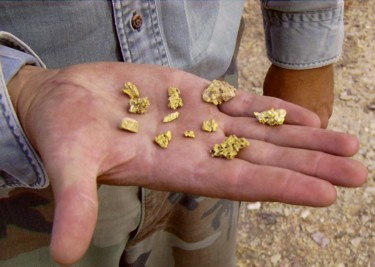 |
|
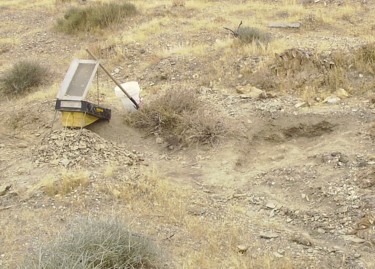 |
After a discussion with Bill Southern, who hosts one of the best Internet
forums on the topic of detecting for nuggets, it was agreed that a Nevada expedition would
be a good idea. After considering the calendar, a four-day prospectors gathering in Nevada
was scheduled for the end of October. I made sure the members of many of the different
internet based gold detecting forums were aware of the event. There are a number of
members of the Silver State detectors of the Reno area who are interested in nugget
shooting, so the event was publicized with the club, and they also joined in. The meeting
place was set as the Rye Patch campground about 23 miles north of Lovelock. This location
is close to the Rye Patch placer area, and not too far from a number of others in the
region. |
| The
focus of the group was working the placers of the Humboldt & Pershing county area in Northern Nevada, and there are a number of sites in
that region that present good opportunities for nugget shooting with a metal detector. In Placer
Districts of Nevada, (USGS Bulletin 1356)
Maureen Johnson lists
115 districts in Nevada, which have recorded placer
production, and most of these are located in the northern half of the State. Nevada is well known for its large hardrock
mine production, and it currently produces more gold than any state in the US. However, Nevada ranks only 6th among the 50 states
in placer gold production, with historic production of roughly 1.7 million ounces. Most of
this placer production occurred before 1900, but sporadic mining and prospecting work has
continued ever since. Nevada placer gold often shows a light tone
because of its high silver content. |
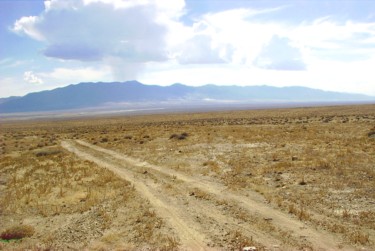 |
|
|
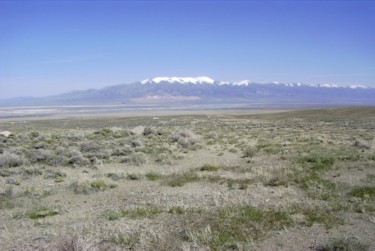 |
Many Nevada placer districts have the majority
of their gold at or near bedrock, which can be a considerable depth. Research on the
geology and history of the old mining Districts can provide the information necessary to
determine if a specific location is suitable for nugget shooting. Districts that are
favorable for nugget shooting have shallow gold that can be found with a metal detector.
Some of the Nevada districts that have been productive for the prospector armed with a
metal detector include the Rye Patch, Placerities, Sawtooth Knob, Rabbit Hole and Rosebud
districts, all of which are located in the Pershing – Humboldt County area. In
addition to placer the Districts, many of the state's lode epithermal vein gold-Quartz
districts offer opportunities to the prospector with a metal detector. Unfortunately, the
famous Carlin district and other sediment-based deposits are not suitable for detecting as
the gold particles at these locations are microscopic, and far too small to be detected. |
|
Northern
Nevada
is also home to the state's best known placer field for nugget shooting with a metal
detector, the Majuba or Rye Patch placer district. The area is located west of the Rye
Patch Reservoir, about 45 miles north of Lovelock in Pershing
County.
The district can be reached by taking the Rye Patch exit off Interstate 80. In spite of
intensive prospecting in the Humboldt region beginning in the 1860's, the placer field was
not discovered until 1938, by local Pershing
County
resident Charles E. Dice. Mr. Dice worked the area by drywashing for several years through
the early 1940's, producing over six hundred ounces of placer gold. Sporadic prospecting
work by others has continued ever since. Gold is found over an area of several square
miles on a pediment spreading out from the east side of the Majuba
Mountain
range, located within T32N R32E, MDB&M. Within that township, placer gold has been
found over a wide area, in parts of sections 8, 17, 18, 19, 20, 29 and 30.
The most outstanding feature of the deposit is it's shallow nature, with most of
the gold being quite near the surface. This makes the area attractive for nugget shooting
with a metal detector. In most areas (other than in the gulleys) the soil is only about
one or two feet deep. |
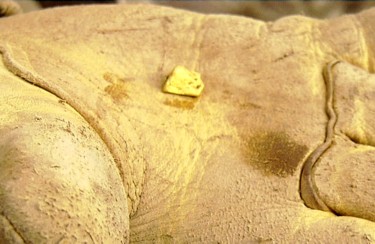 |
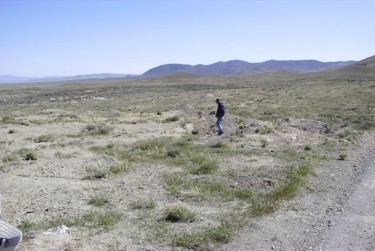 |
Nearly
all mining at Rye Patch has been done near the surface, and little gold has been mined
below a few feet in depth. The bedrock here is composed of slate or shale with some
rhyolitic igneous dikes. There are a lot of areas here where there are dozer scrapings,
but the soil layer is not very deep and many places the dozer cut down a only foot or so
and hit the country rock. Geologically, most of the dozer scrapings were in areas
where there were concentrations of iron stained quartz on the surface. These quartz areas
and the gullies draining between them are the places where one would look for gold. Gold
is found both as gold-quartz specimens and as nuggets of mostly quartz-free gold.
Many of the quartz-free nuggets show a grooved V or chevron shape that is characteristic
of the crystalline gold from this deposit. Not every nugget from Rye Patch shows this
formation, but they are fairly common. Some fairly large specimens have been found,
including nuggets of up to 10 ounces. None of the gold from Rye Patch shows much
indication of traveling far, and no large in-place gold-quartz veins have been found in or
around the deposit. The
source of the gold is likely erosion from the many small, shallow epithermal veins, which
are found through out the placer area. There are no trees in the area of the placer
deposit; only sparse sagebrush covers the surface, as can bee seen in the photos. Before
discovery of the placers, the Majuba
Mountain
area was known principally for its base metal deposits, including an unusual copper-tin
deposit. |
| Property
ownership of the Rye Patch placer area is a checkerboard pattern split between BLM land
and private railroad land. The even numbered sections are private land (originally
Railroad Property) and the odd numbered sections belong to the BLM. There are some claims
on the BLM property, so investigation into land status is necessary - be sure to check
before prospecting. At this time there are claims covering all of sections 20 and 30, be
advised that these owners do not appreciate prospectors working their claims, so be sure
to stay away from these locations. Although the area has been detected extensively since
the 1970's there is still gold to be found. Several of the local Silver State Detectors
club members have found nuggets there during recent years. As far as facilities, some
people dry camp out at the placer site, but there is also an excellent campground with
water at the Rye Patch Reservoir dam, only a few miles from the placer deposits. A
convenience store and gas station is located at the intersection of I-80 and Rye Patch Road. Although some maps show that the
best road might be the road from Polker Brown to the placers, that road is not suitable
even for most 4-wheel drives. It is best come over from the west off the main North-South
road just west of Rye Patch Reservoir. Several good roads run from this road west over to
the placer areas. There are also good dry washing areas for those interested in recovering
gold that way. In addition to the gold, the quartz veins there can yield some nice quartz
crystal specimens as well. |
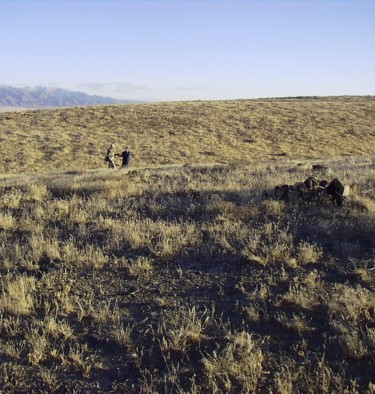 |
|
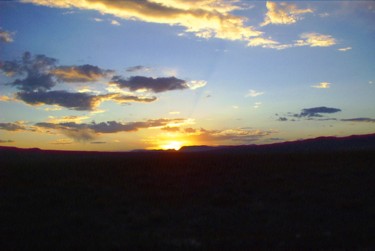 |
In
addition to the gold, the quartz veins there can yield some nice quartz crystal specimens
as well. The weather in Northern Nevada had been warm and mild in the weeks before our end
of October get together, but our luck did not hold out and it turned cold and windy just a
few days before everyone was to arrive. The temperatures went from record high daytime
temperatures to record nighttime lows in only a few days. This did convince a few folks
not to show, and the outing was not as large as had been expected. However, even though it
was unseasonably cool, it did remain dry and everyone who was willing to bundle up to stay
warm got a chance to hunt for nuggets. Those hardy individuals who did make it were eager
to find some gold, and most of the participants did. All in all, over a dozen prospectors
participated, but because of the informal nature of our get together, we were never all in
the same place at the same time. We were too busy swinging our detectors most of the time,
but in spite of this, nearly everyone got to meet and speak with the other participants at
one point or another. The wind died down on Friday night, and the weather on Saturday,
though still cool, was improved, and more comfortable for detecting. However because of
the clear skies, it hit 12 degrees at Rye Patch Dam Ranger Station Saturday night. We were
still at it Sunday morning, but a storm started to come in Sunday afternoon and that put a
damper on things, so most everyone headed toward home. |
| |
| Because of the wide spread nature of an internet based group, a number of
the participants came from out of state, including prospectors from Arizona, Idaho, and Colorado.
Of course, there were also several local folks in attendance from northern Nevada as well.
The skill level of the participants ranged all the way from beginner to experienced
prospector. The original plan for the event was simply for everyone to be on their own for
prospecting during the day, but to get together in the evenings. The winds and cold
weather put a damper on plans for camp fire discussion sessions, as had been held at the Arizona
get together, so in keeping with our informal theme, we just meet in the field during the
day while we were out prospecting. This was possible because everyone nugget shooting
around the Rye Patch area that weekend was associated with the group in one way or
another. |
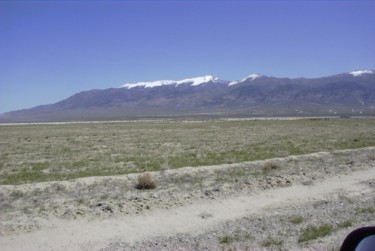 |
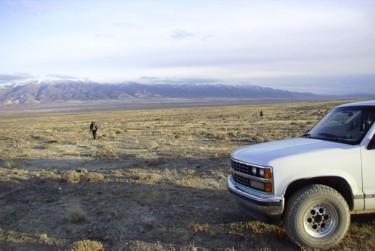 |
The bedrock at Rye Patch is only moderately mineralized, and presents no
difficulties to PI or VLF detectors. Most of the participants were using Pulse Induction
(PI) based detectors made by Minelab equipped with large coils. Because the site at Rye
Patch has been worked so thoroughly, the greater depth possible with large coils is a
significant advantage at that site, especially in areas with deeper bedrock. Some of the
individuals also made side trips to prospect in other nearby districts. I spent some time
prospecting at both the Rochester and Sawtooth Knob areas, as well as the primary area of
interest at Rye Patch. I tried a little dry washing on Sunday. An area of rough bedrock
was exposed in one of the ravines, and I wanted to see if I could get any gold out of it.
One advantage of the hard work of dry washing was that I was fully warm, in spite of the
cold weather! Unfortunately, it didn’t yield as well as I had hoped. |
|
| Even though finding nuggets at Rye Patch takes patience and hard work,
there are still a good number of nuggets being found for those willing to put in the time
and effort. Most of the participants found at least some gold. One of the outing
participants found a cubic shaped crystalline gold nugget. Bill Southern found a nice
Chevron patterned crystalline nugget right in the middle of one of the access roads at Rye
Patch. Everett from Colorado found a nice nugget of about 2/3 thirds penny weight with a
24 inch elliptical mono by Nugget Finders. The largest nugget found weighed 6.5 penny
weight, and was found by Seven-up Jerry (one of our local northern Nevada prospectors)
using a GP 3000 and a Coiltek 14 inch mono coil. It was found at a depth of about 14
inches on the side slope of a small gully. I had the privilege of watching it being
unearthed and photographing it moments after it was washed off. It showed no visible wear
from erosion at all. |
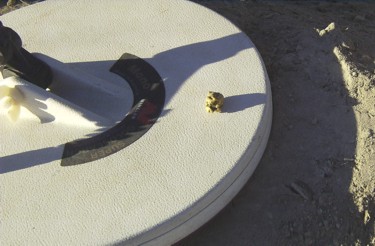 |
|
| |
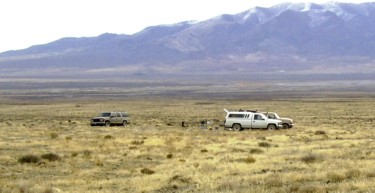 |
Next year, we will schedule this event a little earlier in the year to
take advantage of the warmer weather. Maybe we’ll even see you in northern Nevada for
a nugget hunting trip next year. Until then, you can participate in the forums by joining
us for some prospecting discussions on the internet. There are a number of popular
forums for discussing the subject of gold nugget shooting with a metal detector.
For my latest adventures and articles, check out the
ICMJ Prospecting and Mining Journal Magazine.
I am the Associate Editor there. |
All Copyrights retained by Chris Ralph, do not copy or reprint without permission
|
|












